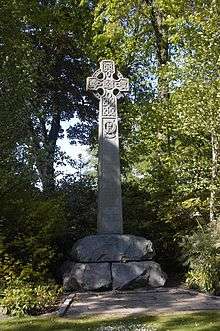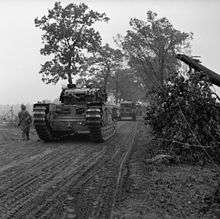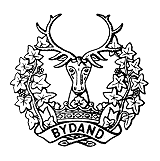Gordon Highlanders
| Gordon Highlanders | |
|---|---|
|
Cap badge of the Gordon Highlanders | |
| Active | 1881–1994 (as Gordon Highlanders) |
| Country |
|
| Branch |
|
| Type | Infantry |
| Size | Line infantry |
| Part of | Scottish Division |
| Garrison/HQ |
Castlehill Barracks, Aberdeen (1881–1935) Gordon Barracks, Bridge of Don (1935–94) |
| Motto(s) | Bydand[1] |
| March | Cock o' the North |
| Engagements |
Mysore Seringapatam Peninsular War South Africa 1899–1902 |
| Battle honours |
Relief of Ladysmith Battle of Kandahar |
| Commanders | |
| Ceremonial chief |
King Edward VIII Henry William Frederick Albert, 1st Duke of Gloucester HRH The Prince of Wales KG KT GCB AK QSO DC |
| Insignia | |
| Tartan |
.png) |
The Gordon Highlanders was a line infantry regiment of the British Army that existed for 113 years, from 1881 until 1994 when it was amalgamated with the Queen's Own Highlanders (Seaforth and Camerons) to form the Highlanders (Seaforth, Gordons and Camerons).
Early history


The regiment was formed on 1 July 1881 instigated under the Childers Reforms. The new two-battalion regiment was formed out of the 75th (Stirlingshire) Regiment of Foot - which became the 1st Battalion of the new regiment - and the 92nd (Gordon Highlanders) Regiment of Foot, which became the 2nd Battalion.[2]
The 1st battalion fought at the Battle of Tel el-Kebir in September 1882 during the Anglo-Egyptian War and then took part in the Nile Expedition in an attempt to relieve Major-General Charles Gordon during the Mahdist War.[3]
The 1st Battalion then took part in the Chitral Expedition and then the Tirah Campaign: it was during operations on the North West Frontier in October 1897, during the storming of the Dargai Heights, that one of the regiment's most famous Victoria Crosses was earned. Piper George Findlater, despite being wounded in both legs, continued to play the bagpipes during the assault. Another of the heroes involved the charge of the Gordon Highlanders at Dargai Heights, was Piper John Kidd. Piper Kidd was with Piper Findlater when, half-way up the heights, both pipers were shot down. Unmindful of his injuries, Piper Kidd sat up and continued to play "The Cock o' the North" as the troops advanced up the heights.[4][5]
The 2nd Battalion fought at the Battle of Elandslaagte in October 1899 and the Siege of Ladysmith in November 1899 during the Second Boer War.[6] Meanwhile the 1st Battalion, who arrived a little later, saw action at the Battle of Magersfontein in December 1899 and was again in action at Doornkop, where they suffered severe losses, in May 1900.[6]
First World War

.jpg)
Regular Army
The 1st Battalion landed at Boulogne-sur-Mer as part of the 8th Brigade in the 3rd Division in August 1914 for service on the Western Front; they suffered heavy losses at the Battle of Le Cateau in August 1914.[7] The 2nd Battalion landed at Zeebrugge as part of the 20th Brigade in the 7th Division in October 1914 for service on the Western Front and then moved to Italy in November 1917.[7]
Territorial Force
The 1/4th (City of Aberdeen) Battalion landed at Le Havre as part of the 8th Brigade in the 3rd Division in February 1915 for service on the Western Front.[7] The 1/5th (Buchan and Formartin) Battalion landed at Boulogne-sur-Mer as part of the 153rd Brigade in the 51st (Highland) Division in May 1915 for service on the Western Front.[7] The 1/6th (Banff and Donside) Battalion landed at Le Havre as part of the 20th Brigade in the 7th Division for service on the Western Front.[7] The 1/7th (Deeside Highland) Battalion landed at Boulogne-sur-Mer as part of the 153rd Brigade in the 51st (Highland) Division in May 1915 for service on the Western Front.[7]
New Armies
The 8th (Service) Battalion landed at Boulogne-sur-Mer as part of the 26th Brigade in the 9th (Scottish) Division in May 1915 for service on the Western Front.[7] The 9th (Service) Battalion and the 10th (Service) Battalion landed at Boulogne-sur-Mer as part of the 44th Brigade in the 15th (Scottish) Division in July 1915 for service on the Western Front.[7]
The folk singer and Scottish Traveller Jimmy MacBeath served with the regiment during the war.[8]
Second World War
_Division%2C_during_the_assault_on_Tilburg%2C_Holland%2C_28_October_1944._B11420.jpg)

The 1st Battalion, Gordon Highlanders was a Regular Army battalion that served originally with the 2nd Infantry Brigade, part of the 1st Infantry Division, and was sent to France in September 1939, shortly after the declaration of war, as part of the British Expeditionary Force (BEF): it remained there until May 1940. On 7 March 1940 the 1st Battalion exchanged with the Territorial 6th Battalion and transferred to the 153rd Infantry Brigade, part of the 51st (Highland) Division. The battalion served with the 51st Division during the Battle of France in 1940 when they were trapped and the majority of the division was forced to surrender at Saint-Valéry-en-Caux, with very few men escaping capture. The 1st Battalion was, however, reformed in the United Kingdom in August 1940 and went on to serve with the second formation of the 51st (Highland) Division (formed by redesignation of the 9th (Highland) Infantry Division throughout the rest of the Second World War, serving in North Africa at El Alamein, Tunisia, Sicily and North-western Europe, ending the war in Germany.[9]
The 2nd Battalion was based in Malaya as part of the Singapore garrison and fought in the battle for Singapore in February 1942, surrendering along with 130,000 other British Commonwealth soldiers on 15 February. The men of this battalion suffered more casualties as Prisoners of War in Japanese captivity than they did during the fighting on Singapore Island and Malaya. The 2nd Battalion was reformed in May 1942 from personnel of the 11th Battalion and fought with the 15th (Lowland) Division, throughout North West Europe. They formed part of 227th (Highland) Brigade - the Junior brigade in the division. They were involved in the heavy fighting around Cheux and Tourville-sur-Odon in Normandy, the fight for the Netherlands and in the Battle of Uelzen in Germany near to the end of the war.[10]
The 4th (City of Aberdeen) Battalion served as a Machine Gun Battalion in the Battle of France and was later converted to a Royal Artillery regiment on 1 November 1941, becoming the 92nd Anti-Tank Regiment, Royal Artillery, as part of the 9th Armoured Division, but saw no active service during the war.[11]
The 5th Battalion went to France as part of the British Expeditionary Force: they were serving as part of the 153rd Brigade in the 51st Division during the Battle of France in 1940 when they were trapped and the majority of the division was forced to surrender at Saint-Valéry-en-Caux. The 5th Battalion was, however, reformed in the United Kingdom in August 1940 and went on to serve with the second formation of the 51st (Highland) Division (formed by redesignation of the 9th (Highland) Infantry Division throughout the rest of the Second World War, serving in North Africa and taking part in the Normandy landings.[12]
The 6th (Banffshire) Battalion, a Territorial Army battalion, was transferred from the 153rd Brigade in the 51st (Highland) Division before it joined the 2nd Infantry Brigade of the 1st Infantry Division. It took part in the Dunkirk evacuation. The 6th Battalion fought through the Tunisian, North African and Italian campaigns, in both the Battle of Anzio and Operation Diadem, and later the Battle for the Gothic Line, before ending the war on garrison duty in Palestine.[13]
The 7th (Mar and Mearns) Battalion amalgamated with the 5th Battalion, becoming the 5th/7th Battalion, Gordon Highlanders, and served with the second formation of the 51st (Highland) Division throughout the war.[14]
The 8th (City of Aberdeen) Battalion was also converted to artillery, becoming the 100th Anti-Tank Regiment, Royal Artillery. This battalion served with the 2nd Infantry Division in the Burma Campaign.[15]
The 9th (Donside) Battalion (originally part of the 9th (Highland) Infantry Division along with the 11th Battalion) were initially posted to the Shetland islands. Later they were amalgamated with the 5th Battalion and sent to India for training. Converted to an armoured regiment in 1942 as the 116th Regiment Royal Armoured Corps (Gordons), they continued to wear the Gordons cap badge on the black beret of the RAC.[16] 116th RAC were sent to India and joined 267th Indian Armoured Brigade; later they served in Burma where as part of 255th Indian Tank Brigade they were involved in the dash for Rangoon and were heavily involved in the battle of Meiktila, signalling the end of Japanese hopes in Burma.[17]
Post-War
After the war the Gordons saw active service in the Malayan Emergency, Cyprus, and Northern Ireland. The Regiment was amalgamated with The Queens' Own Highlanders (Seaforth and Camerons) on September 17, 1994 to form The Highlanders (Seaforth, Gordons and Camerons).[18] In 1997, the Gordon Highlanders Museum opened, in the former regimental headquarters in Aberdeen.[19]
Victoria Cross recipients
75th (Highland) Regiment of Foot
- Richard Wadeson (Indian Mutiny, 1857)
- Patrick Green (Indian Mutiny, 1857)
- Cornelius Coughlan (Indian Mutiny, 1857)
92nd (Gordon Highlanders) Regiment of Foot
- George White (Afghanistan, 1879)
- William Henry Dick-Cunyngham (Afghanistan, 1879)
Gordon Highlanders
- Edward Lawson (India, 1897)
- George Findlater (India, 1897)
- Matthew Meiklejohn (Second Boer War, 1899)
- William Robertson (Second Boer War, 1899)
- Ernest Towse (Second Boer War, 1900)
- John Mackay (Second Boer War, 1900)
- William Gordon (Second Boer War, 1900)
- David Younger (Second Boer War, 1900)
- William Kenny (France, 1914)
- James Brooke (France, 1914)
- George McIntosh (France, 1917)
- Allan Ker (France, 1918)
- George Mitchell (Italy, 1944)
Battle honours
Battle honours awarded to the regiment included:[18]
- Early Wars: Mysore, South Africa 1835, Tel-El-Kebir, Egypt 1882 '84, Nile 1884–5, Chitral, Tirah, Defence of Ladysmith, Paardeberg, South Africa, 1899–1902
- The Great War: Mons, Le Cateau, Retreat from Mons, Marne 1914 '18, Aisne 1914, La Bassée 1914, Messines 1914, Armentières 1914, Ypres 1914 '15 '17, Langemarck 1914, Gheluvelt, Nonne Bosschen, Neuve Chapelle, Frezenberg, Bellewaarde, Aubers, Festubert 1915, Hooge 1915, Loos, Somme 1916, 18, Albert 1916 '18, Bazentin, Delville Wood, Pozières, Guillemont, Flers-Courcelette, Le Transloy, Ancre 1916, Arras 1917 '18, Vimy 1917, Scarpe 1917 '18, Arleux, Bullecourt, Pilckem, Menin Road, Polygon Wood, Broodseinde, Poelcapelle. Passchendaele, Cambrai 1917 '18, St. Quentin, Bapaume 1918, Rosières, Lys, Estaires, Hazebrouck, Béthune, Soissonnais-Ourcq, Tardenois, Hindenburg Line, Canal du Nord, Selle, Sambre, France and Flanders 1914–18, Piave, Vittorio Veneto, Italy 1917–18
- The Second World War: Withdrawal to Escaut, Ypres-Comines Canal, Dunkirk 1940, Somme 1940, St. Valery-en-Caux, Odon, La Vie Crossing, Lower Maas, Venlo Pocket, Rhineland, Reichswald, Cleve, Goch, Rhine, North-West Europe 1940, '44–45, El Alamein, Advance on Tripoli, Mareth, Medjez Plain, North Africa 1942–43, Landing in Sicily, Sferro, Sicily 1943, Anzio, Rome, Italy 1944–45
Alliances
 Canada - The 48th Highlanders of Canada
Canada - The 48th Highlanders of Canada Canada - The Toronto Scottish Regiment (Queen Elizabeth The Queen Mother's Own)
Canada - The Toronto Scottish Regiment (Queen Elizabeth The Queen Mother's Own) Australia - 5th Battalion, The Victorian Scottish Regiment
Australia - 5th Battalion, The Victorian Scottish Regiment Australia - 5th and 6th Battalions, The Royal Victoria Regiment
Australia - 5th and 6th Battalions, The Royal Victoria Regiment Australia - 5th/7th Battalion, The Royal Australian Regiment
Australia - 5th/7th Battalion, The Royal Australian Regiment South Africa - The Cape Town Highlanders
South Africa - The Cape Town Highlanders
Notes
- ↑ Meaning abiding, steadfast, an adjectival use of the Middle Scots present participle of bide.
- ↑ The London Gazette: no. 24992. pp. 3300–3301. 1 July 1881. Retrieved 30 May 2016.
- ↑ "History of the Gordon Highlanders". Gordon Highlanders. Retrieved 30 May 2016.
- ↑ "Death of Piper Kidd". The Argus. 21 May 1934. p. 8. Retrieved 30 May 2016.
- ↑ The London Gazette: no. 26968. p. 3165. 20 May 1898. Retrieved 30 May 2016.
- 1 2 "Gordon Highlanders". Anglo-Boer War. Retrieved 30 May 2016.
- 1 2 3 4 5 6 7 8 "Gordon Highlanders". The Long, Long Trail. Retrieved 31 May 2016.
- ↑ "Portsoy's Haal festival remembers folk legend Jimmy MacBeath". The Scotsman. 21 May 2016. Retrieved 30 May 2016.
- ↑ "1st Battalion, Gordon Highlanders". Wartime Memories Project. Retrieved 3 June 2016.
- ↑ "2nd Battalion, Gordon Highlanders". Wartime Memories Project. Retrieved 3 June 2016.
- ↑ "4th Battalion, Gordon Highlanders". Wartime Memories Project. Retrieved 3 June 2016.
- ↑ "5th Battalion, Gordon Highlanders". Wartime Memories Project. Retrieved 3 June 2016.
- ↑ "6th Battalion, Gordon Highlanders". Wartime Memories Project. Retrieved 3 June 2016.
- ↑ "7th Battalion, Gordon Highlanders". Wartime Memories Project. Retrieved 3 June 2016.
- ↑ "8th Battalion, Gordon Highlanders". Wartime Memories Project. Retrieved 3 June 2016.
- ↑ Forty p. 51.
- ↑ "9th Battalion, Gordon Highlanders". Wartime Memories Project. Retrieved 3 June 2016.
- 1 2 "Gordon Highlanders". Regiments.org. Archived from the original on December 30, 2005. Retrieved 30 May 2016.
- ↑ "Gordon Highlanders Museum". Retrieved 3 June 2016.
References
- Forty, George (1998). British Army Handbook 1939–1945. Sutton Publishing. ISBN 0-7509-1403-3.
Further reading
- Royle, Trevor (2007). The Gordon Highlanders A Concise History. Mainstream Publishing Company. ISBN 9781845962708.
External links
| Wikimedia Commons has media related to Gordon Highlanders. |
- Gordon Highlanders Museum
- History of the Regiment
- "Cock o' the North" on YouTube
- Gordon Highlanders Online Meeting place for Gordon Highlanders
- GORDON HIGHLANDERS (1899) (archive film from the National Library of Scotland: SCOTTISH SCREEN ARCHIVE)
